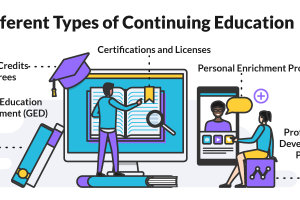
Introduction
Continuing education plays a crucial role in personal and professional growth, enabling individuals to stay relevant, acquire new skills, and adapt to a rapidly evolving world. As technology advances and learning methodologies transform, it is essential to stay informed about the latest trends in continuing education. In this article, we will explore key trends to watch in continuing education, incorporating the latest technologies, real-life examples, and quotes from notable figures.
- Digital Learning and Online Courses
Digital learning and online courses have revolutionized continuing education, providing flexible and accessible options for learners worldwide. The following aspects highlight the importance and impact of digital learning:
1.1 Flexibility and Accessibility
Online courses offer learners the flexibility to study at their own pace and convenience. Learners can access course materials, participate in discussions, and submit assignments from anywhere in the world. This flexibility removes geographical barriers, allowing individuals to access quality education regardless of their location.
1.2 Personalization and Adaptive Learning
Digital learning platforms leverage technologies such as artificial intelligence and machine learning to provide personalized learning experiences. Adaptive learning systems analyze learners’ performance and tailor course content to their individual needs, optimizing the learning journey and ensuring maximum engagement and retention.
1.3 Microcredentials and Digital Badges
Microcredentials and digital badges have gained popularity in the digital learning landscape. These bite-sized certifications validate specific skills and competencies, making them valuable additions to individuals’ resumes and professional profiles. Platforms like Coursera, Udemy, and LinkedIn Learning offer a wide range of microcredential programs.
- Blended Learning and Hybrid Models
Blended learning combines online and face-to-face components, creating a dynamic and interactive learning experience. Hybrid models incorporate both traditional classroom settings and virtual components. The following aspects highlight the significance of blended learning:
2.1 Integration of Technology and Traditional Methods
Blended learning combines the benefits of technology-enhanced instruction with the interpersonal dynamics of in-person interactions. Learners can access online resources, engage in discussions, and collaborate with peers while still benefiting from the guidance and expertise of instructors in physical classroom settings.
2.2 Flipped Classroom Approach
The flipped classroom approach is a popular strategy in blended learning, where learners engage with course content online before attending in-person sessions. This approach maximizes classroom time for discussion, collaboration, and hands-on activities, fostering deeper understanding and application of concepts.
2.3 Synchronous and Asynchronous Learning
Blended learning allows for both synchronous (real-time) and asynchronous (self-paced) learning experiences. Learners can participate in live virtual sessions with instructors and peers, as well as access pre-recorded lectures and materials at their convenience. This flexibility accommodates diverse learning styles and schedules.
- Lifelong Learning and Continuous Skill Development
Lifelong learning has become a necessity in a rapidly changing job market. The following aspects emphasize the importance of continuous skill development:
3.1 Professional Development and Upskilling
Professionals are recognizing the need to continuously upgrade their skills to remain competitive in their fields. Employers are also investing in employee development, offering training programs and resources to enhance their workforce’s capabilities. Online platforms, corporate training programs, and workshops are popular avenues for professional development.
3.2 Emphasis on Soft Skills
In addition to technical expertise, there is a growing emphasis on soft skills development. Skills such as critical thinking, communication, adaptability, and leadership are highly valued in the workplace. Continuing education programs are incorporating modules and courses to foster these essential skills.
3.3 Learning for Personal Enrichment
Lifelong learning extends beyond professional development. Many individuals engage in continuing education to pursue personal interests, explore new hobbies, or simply satisfy their curiosity. Online platforms, community education programs, and adult learning centers offer a variety of courses catering to diverse interests.
Conclusion
Continuing education is evolving to meet the demands of an ever-changing world. Digital learning, blended models, and lifelong learning trends are transforming how individuals acquire knowledge and skills. As Mahatma Gandhi once said, “Live as if you were to die tomorrow. Learn as if you were to live forever.” Embracing these trends and staying informed about the latest advancements in continuing education will empower individuals to thrive, adapt, and achieve personal and professional growth throughout their lives.

















